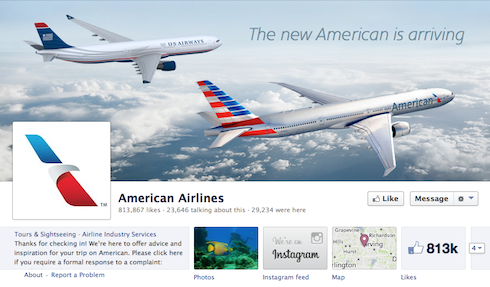By adaptive - September 17th, 2013
American Airlines serve 250 cities in over 40 countries with, on average, more than 3,400 daily flights. American Airlines offers up to 37 daily non-stop departures from Europe to the US
Jonathan Pierce, Director Social Communications, American Airlines

Jonathan is responsible for global social media strategy, and leadership of social communications for American across all networks. He developed dedicated in-house social team spanning customer service, customer engagement, metrics and analysis, community management and marketing creative services. Jonathan also led American to attain awards and recognition for social media strategy and presence, including number 2 in Top 100 Social Brands (2013), and award-winning customer service.
What are the key drivers behind your organization’s use of social media?
At the core of American’s social media strategy is giving our customers a place to be inspired by travel and experience the world through the lens of American Airlines. We listen every minute of every day to what our customers are telling us, and that helps shape the content we create, the issue resolution we provide, and the loyalty we work hard to earn and retain.
How is social media organised within your company?
The social media team resides within our Communications group, collaborating closely with marketing, customer service, IT and airport teams. Our core team is divided into two primary functions: engagement and service. The customer engagement team is responsible for creating our message campaigns and promotions, while the customer service team responds and assists customers 24/7.
As a corporate user of social networks, how does your company value the networks it has a presence on?
Over the years, we've gone to great lengths to ensure that we have a unique use strategy for each of our social networks: @AmericanAir on Twitter, and American Airlines on Facebook, Google+, YouTube, Pinterest, Instagram, and LinkedIn. A campaign may use a certain set of networks to tell a story, and use a different set of networks to tell another story. That flexibility is important to our social initiatives.

Can you outline a recent initiative that included a social media component?
In March 2013, American was Official Airline Sponsor of SXSW. Our social media objectives was to connect and engage with customers and influencers in SXSW's high-profile, high-value, yet high-clutter digital environment. American’s sponsorship was infused with social media throughout all experiential and digital aspects to the activation, and we were pleased with the brand impact our activations had at the event.
How much pressure is there to show ROI with the social media you use?
Analytics are at the heart of American’s social strategy. We use data insights to optimize our messaging performance, and report on customer feedback and the performance of projects and campaigns. If you are using data to tell the story of what customers are saying, and the business is listening and acting on that feedback, then you are inherently receiving ROI from social. The art is telling the story in a simple, compelling way, and translating the insights to be relevant to different stakeholders.
How did your organisation approach the mapping of your enterprise to identify where social media should reside in the corporate structure? And how this would deliver an integrated approach to social media activity?
In 2009 when we formally launched American's social media program, our view at that time was that social media inherently needed to be a Communications function with strong links to other departments, and that view has remained. The launch pad for social residing in Communications was being connected to news and announcements and as part of a group that naturally partners with other teams to build engaging content to promote the business.
The organizational decision was also influenced by our need to monitor and quickly respond to operational and service issues that can quickly escalate into corporate reputation challenges. We are a complex, global operation, with millions of customer touch points each day. That influences our engagement and content decisions. For example, if we are experiencing challenges due to weather, we can’t pretend that the customers’ world is all rainbows and unicorns. We must constantly listen, assess, respond and, equally important, adjust.
For a company with a handful of products, and little to no variation in service quality – like a soft drink – that social strategy can be much more focused on marketing, promotions, sales and humor. Ultimately, it comes down to understanding your customer, your company’s customer proposition and relationships, and then defining its social media goals and objectives, determining where the best resources for social media are located, and building a strategic framework that will best serve it.
What is your advice to organisations that are beginning to map their own corporate structure with the view to embedding social media activity within their enterprise?
Start by listening to what your customers are saying and what they want to know. With that understanding, you should define if the customer relationship is with an individual product or brand, such as a certain type of car or beer, or if it is with the whole company. You need to decide the type of community you want to have, and determine the breadth of stories you want to share. Social should map to where your customer expectations and needs can best be served, and where the breadth of brand stories can best be created.
Wherever the reporting line for social is in the organization, I would suggest there are strong relationships with all other stakeholders. That’s why we adopted a client-service model, through which our team helps our colleagues in the business leverage the power of social media to meet their business objectives. And, of course, we partner with our traditional Communications team, to ensure there is a unique social strategy to enhance company announcements. Social media is a representation of your company and everyone should feel involvement with it, and feel they can provide input to it. Organizational ownership should be a case of governance, specialist social skills, protecting corporate reputation, insights analytics, and being an advocate for the customer.
Are there any specific tools you employ that help your business manage its social media activity across multiple departments?
We track our content through a SharePoint platform, backed up by a robust process for sharing information across multiple departments, that includes in-person meetings, conference calls, and email. Externally, we use a variety of tools to track and measure campaigns, as well as communicate regularly with customers.
How do you see the management and development of social media in your company evolving over the next few years?
Social media continues to mature at American, as it permeates different groups and social insights are integrated into thinking and decisions. Social media has become a permanent fixture in American’s culture, and that continues to open doors for us to build new and deeper relationships internally. We see opportunities to scale social across the customer experience, both back-end and at the point of service.
Next Reads
September 2013, Webinar
Join us, Adobe, Intel and American Airlines at this free webinar. Learn how to; create valuable and exciting content, discover the impact of social media on your business and forward plan for 2014
Brochure Programme